Last May, I spent a few hours in Totteridge, in the English County of Hertfordshire. I was wandering along Totteridge Lane, a description perhaps of that which it once probably was, but certainly is not now. Ignoring the present day I enjoyed, as I often do when walking the steps of my ancestors, imagining what it was like in the 18th century. To enhance my day dreaming, I found lots of pleasant leafy covered ways off the roadside that blocked out the modern road and cars, allowing my mind to take me back to a time when, for this family, who you were mattered. To the right in this photo I think one such walkway is coming up.
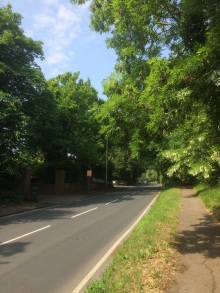
Totteridge Lane. My Collection 2018
Although close to the road it was also a welcome respite from the surprisingly hot sun.
Totteridge Lane. My Collection 2018
My mission in Totteridge was in the graveyard of the parish Church of St Andrew where it was said there was an 18th century vault where my first cousin eight times removed, Edward Williams and his wife, Elizabeth nee Capper were laid to rest.
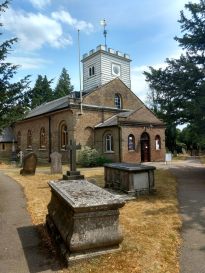 St Andrew’s Church, Totteridge Photo by Philafrenzy – Own work CC BY-SA 4.0, Source Commons Wikimedia*
St Andrew’s Church, Totteridge Photo by Philafrenzy – Own work CC BY-SA 4.0, Source Commons Wikimedia*
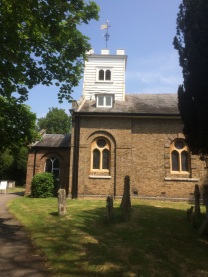 St Andrew’s Church, Totteridge. My Collection 2018
St Andrew’s Church, Totteridge. My Collection 2018
It was a lovely church and a beautiful sunny day but not good for my own photography. The churchyard was obviously old with an amazing Yew Tree, a symbol of immortality. The tree is said to be between 1000 and 2000 years old.[I]
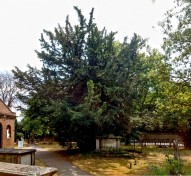 The Yew tree at St Andrew’s Churchyard, Totteridge. Photo by Philafrenzy – Own work CC BY-SA 4.0, Source Commons Wikimedia*
The Yew tree at St Andrew’s Churchyard, Totteridge. Photo by Philafrenzy – Own work CC BY-SA 4.0, Source Commons Wikimedia*
Edward Williams and Elizabeth Capper had married in Westminster Abbey on 18th December 1753. It was a Tuesday, Henry Pelham was Prime Minister and Edward, at the age of 31 years was a young Barrister-in-Law with, one imagines, a bright future ahead of him. It is believed he was the son of Edward Williams and his wife, Mary nee Bayly. Elizabeth was the daughter of Francis Capper and his wife, Mary nee Bennett. She was a granddaughter of Richard Capper, the Lord of the Manor, Bushey in County Hereford, and where Elizabeth was most likely born in 1725. As Edward’s father had passed away in February 1752, one could speculate that with the inheritance that he received, young Edward was now financially stable and had the means to support a wife of the class he aspired to marry.
The marriage was noted in Gentleman’s Magazine and said he was of Serjeant’s Inn.[ii] When he wrote his Will, one year later in 1754, Edward also said he was of Serjeant’s Inn, Fleet Street London.[iii] However, their marriage licence stated he was of Inner Temple. [iv]
Further, his Memorial Inscription says he was at Middle Temple, however he does not appear in the Admission Books from 1740 to 1760, so I have not been able to confirm he was ever at Middle Temple. [v]
Meanwhile, Serjeant’s Inn, by 1754, was no longer a society of serjeants at law. It was merely an address being leased out as chambers to lawyers and other professionals.[vi] The archivist at Middle Temple advised similarly of rental of chambers out to others there.[vii] To add to the confusion, his death notice in Gentleman’s Magazine records that he was a Judge at the Sheriff’s Court.[viii]
Following up on the lead from the marriage licence though, I contacted the archivist at Inner Temple who passed on the following information:
Edward Williams, gent. son and heir apparent of Edward Williams of the parish of All Hallows London Wall, esquire, was admitted to the Inner Temple on 3 May 1737. (ADM/5/2) He was called to the bar on 29 June 1745 and was admitted to chambers in the second staircase in Inner Temple Lane on 2 May 1746 for life (A Calendar of Inner Temple Records Vol IV pp 490, 502). He was nominated as one of three names of experienced barristers put forward to Clifford’s Inn for Reader on 14 May 1757. By 17 May 1759, he was dead and his chambers in Inner Temple Lane reverted to the Inner Temple (A Calendar of Inner Temple Records Vol IV pp 85,107).[ix]
The couple settled in Totteridge, purchasing the property Poynter’s Grove in 1758 from the representatives of Sir Peter Meyer, Knt. The property was a five-bay, two storey house with two-bay pavilion wings and tall hipped roofs. Sadly, the house was demolished in 1925.[x] It was situated at the junction with Totteridge Green and Totteridge Lane, on the north side. Some of the garden wall still survives in Totteridge Village.[xi] I have since discovered it is situated within the gardens of houses 6 – 16.[xii] I must have wandered past where it stood and admired the area, not realising how close I was.

Poynter’s Grove with permission Nick Kingsley [xiii]

Map from Drury and Andrews 1766 Map of Hertfordshire showing Mrs Williams residence in Totteridge.
Elizabeth considerably improved Poynter’s Grove. She had the wings and the interior redecorated. A set of engravings made of the house and its surroundings in 1926 may have been done with commemorative intent due to its recent demolition. [xiv] Elizabeth also improved the grounds and these were designed by Capability Brown, a well- known landscape designer of the time.[xv]
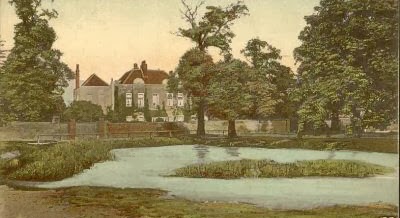 Poynter’s Grove by Edward Gordon Smith (1857 – 1906) [xvi]
Poynter’s Grove by Edward Gordon Smith (1857 – 1906) [xvi]
Prior to my visit, I had inquired of the Church if I would be able to visit the church and vault and they very kindly gave me excellent directions to the grave:
If you turn left out of the vestry door, and go straight ahead through the row of graves parallel with the hedge in front of your car, it is the large vault surrounded with cast iron fencing.
The vestry referred to is at the back of the church, a brown door with a Parish Office sign on it, so imagine you are coming out of that door, and turn left, then follow the instructions.
I was already armed with a copy of the Wills of both Edward and Elizabeth and with a transcription of the memorial inscription:
Here rest the remains of Edward Williams, Esq. Late of the Middle Temple, London, Barrister-in-law, who departed this life on the 6th of February 1759 aged 35. At an age which the love of pleasure is most strong and with a genius to which diligence is least necessary he was indefatigable in the study of his profession that superior knowledge and happy elocution which abilities and application waited to give him integrity directed him to use in the intercourse of social and domestic life the active benevolence of his heart rejoicing in every opportunity of imparting happiness and relieving misery rendered his life a blessing to mankind and endeared him to an affectionate wife who from the tenderest regard to his memory caused this monument to be erected.
In the same Vault are deposited the remains of Elizabeth Williams who attached to the scenes of early happiness and ever mindful of the once dear society of an affectionate and beloved husband passed an exemplary widowhood of 34 years in this parish and in patient expectation of that hour which should reunite her to the object of her affection adorned the doctrine of God her saviour in all things “doing justice and loving mercy and humbly walking with her God.” She died 2nd of February 1793 aged 65 years.
Arms
At the foot of the vault of Edward Williams and Elizabeth Capper:- On a Bend three Fish hauriant and a Canton for WILLIAMS; impaling (Or); on a Chevron (gules) three Roses (argent), a Canton (of the last) for CAPPER.”
I had first heard about the inscription on the vault from my now late third cousin, Peter Foard. Peter was researching this side of our family back in the 1970’s when I was more interested in going out with my friends. We found each other though in the 90s when he had gone on to other things and I was starting out. He was more than happy that I had taken up the batten and gave me an enormous amount of help.
Peter told me he had visited the grave in St Andrew’s graveyard. He didn’t mention what the inscription said, so perhaps he couldn’t read it, but he did say there was a coat of arms on it that he had not been able to identify. Fortunately it was transcribed as above, I believe, by Robert Clutterbuck in the early 19th century.[xvii]
The inscription on the vault, both in memory of her husband and the one in memory of Elizabeth herself, aroused a curiosity in me about the person and the times in which she lived and naturally the desire to visit if ever the chance arose.
I quickly found my way to the Vestry door and then across to the grave without too much trouble. The Williams vault seems to be the only one left with the fence still intact.
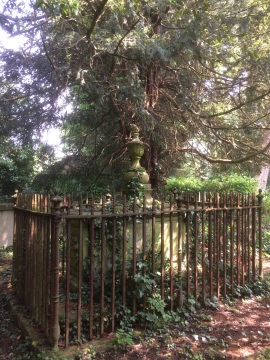 The Williams vault St Andrew’s Churchyard Totteridge, My Collection 2018
The Williams vault St Andrew’s Churchyard Totteridge, My Collection 2018
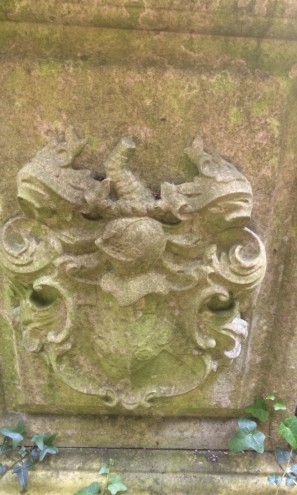 Coat of Arms on the Williams vault St Andrews Totteridge Churchyard, My Collection 2018
Coat of Arms on the Williams vault St Andrews Totteridge Churchyard, My Collection 2018
 Side of the Williams vault with inscription, My Collection 2018
Side of the Williams vault with inscription, My Collection 2018
As can be seen in the photos the vault is in good repair for a vault so old. There is a little damage to the ornament on top and ivy has begun to take hold. I pulled some off to look at the inscription but I could only make out a few words.
In her rather lengthy Will, Elizabeth shows her concern regarding the vault, its upkeep and its security so that it may never be opened again.[xviii]
Keeping the vault in good repair
… I give unto the said John Skirrow and George Samuel Wegg [her executors] and my Niece the said Dorothea Capper the sum of Four hundred Pounds to be paid out of my Personal Estate In Trust to place and keep the same out at Interest upon Government Stocks Funds or Securities as they or the Survivor of them or the Executors or Admors of such Survivor shall from time to time think fit and proper and by and with the Interest and produce thereof to keep the Vault in Totteridge Church yard where my late Dear Husband lies interred in good repair at all times…
Ensuring that the vault never be opened again
…and subject thereto In Trust to pay the Surplus of the Interest and Produce if any unto the Minister Churchwarden and Overseers of the Poor of the Parish for the time being to be applied for or towards the support of any Sunday Schools there provided nevertheless and upon this Condition that the said Minister Churchwardens and Overseers never suffer the said Vault to be opened after my Interment therein upon any Account and in Case they shall so do I revoke the said Bequest of the Surplus Interest and produce of the said Money and do in such Case will and Direct that my said Executors and the Survivor of them and the Executors and Admors of the Survivor to keep and retain such surplus Interest & produce to their and his own use and benefit…
Burial instructions
…and I desire to be interred in the Vault with my said late Dear Husband and that my Body may be inclosed in a Leaden Coffin and carried by six of my Poor Neighbours and I Give unto each of them one Guinea and it is my request that the Vault be not opened until the Morning of my Interment and that I am buried in the Morning or in time to have the Vault bricked and done up before Night in a strong and substantial manner so as never to be opened again I particularly recommend this to the Care of my Executors and the said Dorothea Capper …
Although the executors and her niece, Dorothea, are long gone to join her and the funds, if any, probably absorbed into church funds, I think Elizabeth would be well pleased that the fence is still there and that the vault is in good repair some 220 years later. Ivy was trying to take over but it appears to be cleared regularly and I suspect the ornament atop has been damaged. Grave robbers were obviously a great concern for her and their vault was the only one I saw with a fence, although that may not have always been the case.
Elizabeth expressed a wish to be buried in a leaden coffin. In England, it has long been law that a coffin for interment above ground should be sealed; this was traditionally implemented as a wooden outer coffin around a lead lining, around a third inner shell. After some decades have passed, the lead may ripple and tear. A burial vault serves as an outer enclosure for buried remains and the coffin serves as an inner enclosure. The primary purpose of the vault is to prevent collapse of the coffin due to the weight of the soil above.[xix] Something I also learnt while researching vaults was that there was often a stench in the graveyards from the vaults as the bodies decayed and that was why lead was introduced.
Elizabeth and Edward had no children. In her Will, Elizabeth left the property of her husband to his father’s relation Edward Beavan and if he should die without issue then it should go to John, Henry and Frederick Beavan the sons of John Beavan the brother of Edward Beavan. Edward Williams the husband of Elizabeth, was the grandson of our 8 x Great Grandfather Edward Williams, Vicar of Chepstow who died in 1692 and left a substantial estate which his grandson Edward, an only child, eventually inherited.
There was a contest though as there were other descendants of Edward Williams, Vicar of Chepstow. I thank them eternally for fighting for the money. Chancery is full of claims and counterclaims, newspapers have accounts of the claims and records of the eventual sale of the properties. The relevant records are full of family history, and it is just as well, as finding them in parish records is mostly unsuccessful. The inheritance from the Grandfather of Edward Williams of Totteridge is a saga stretching over more than 150 years and is for another day
34 years! I do hope her wait was worth it!
